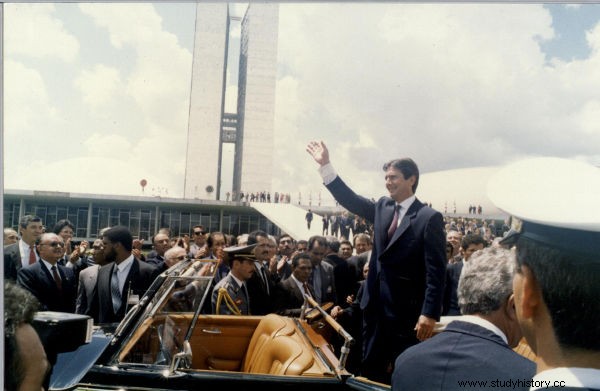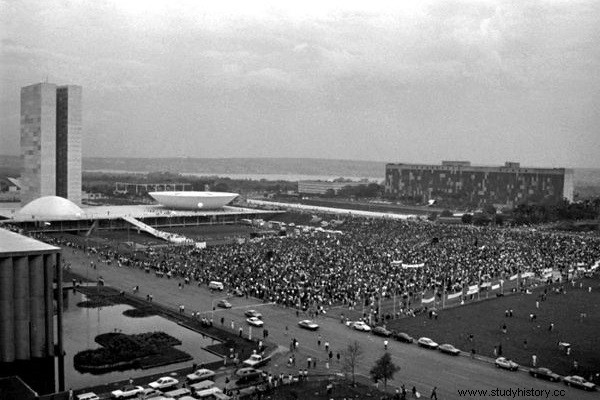The government of Fernando Collor de Mello was recorded in Brazilian history for being the first elected directly after the end of the dictatorship. Collor was elected in the midst of a fierce contest that featured more than 20 candidates. He defended a liberal agenda and the downsizing of the State, defeating the PT candidate, Lula.
Collor's government, however, was a great failure, and he became known for acting in a authoritarian, trying to impose its will and not respecting the dictates of democracy. Collor also failed to combat Brazil's economic crisis, and, after being denounced for his direct involvement in a corruption scheme, he was impeached. .
Read more: Frente Ampla - attempt at political articulation against the dictatorship by Jango, JK and Carlos Lacerda
1989 Election
The 1989 election was an important moment in Brazil's history, as it was the first direct presidential election in nearly 30 years — the last being in 1960. single”, that is, in 1989, the Brazilian population voted solely for president.
The functioning of the 1989 election was determined by the Citizen's Constitution, enacted the previous year, and by Law nº 7773/89 . This election was characterized by the lack of coalitions in the first round, and thus numerous parties launched their own candidate. This was because, since it was the first election in almost 30 years, all parties wanted to test their influence and went looking for a place in the sun.
This made the 1989 election 22 candidates, among whom was a woman, Lívia Maria Lêdo Pio de Abreu, the first woman to run for president in the history of Brazil. This election was also marked by the involvement of many unknown parties and candidates, who sought expression through the presidential candidacy.
Login also :History of elections in Brazil and around the world – summary and history of the vote
The first round featured names already quite influential in national politics, such as Leonel Brizola , Ulysses Guimarães , Luiz Inácio Lula da Silva , Paul Maluf , Mario Graves and Aurelian Keys . Fernando Collor, in turn, at the beginning of the dispute, was a little-known politician (in politics, the expression outsider is used to non-traditional candidates) who only had regional projection in the state of Alagoas due to the influence of his family.
At the beginning of the electoral campaign, the candidate who had the preference of the population was Leonel Brizola, from the PDT. What was seen throughout 1989 was the stagnation of the Brizola campaign and the growth of those of Lula and Collor. The presentation of campaign proposals took place mostly on TV via free electoral propaganda.
The result of the first round among the top five:
-
Fernando Collor (PRN) – 30.47%
-
Luiz Inácio Lula da Silva (PT) – 17.18%
-
Leonel Brizola (PDT) – 16.51%
-
Mário Covas (PSDB) – 11.51%
-
Paulo Maluf (PDS) – 8.85%
An important observation was the fierce dispute between the two great candidates of the left in this election, and the difference between the result of Lula and Brizola was less than 400 thousand votes. As no candidate obtained an absolute majority of votes, a second round between Collor and Lula was sent.
The two candidates who contested the second round of this election had totally different proposals for the country. These differences were noticeable above all in the area of economics , since:
Collor attacked the gigantism of the State and the “maharajas” who gorged themselves on public money without working and without merit; and he defended a liberal reformism that would break the closed character of the Brazilian economy and integrate Brazil into the “First World”. Lula adopted the economic rhetoric of the old Brazilian Democratic Movement (MDB), that of distributive developmentalism, which demanded state-led development that aimed at economic growth without neglecting equality, income distribution|1|.
In the second round, a series of parties joined Fernando Collor:PDS, PFL, PTB, PDC, PL and some members of the PMDB. This joining of parties supporting Collor is understood by historians more as an anti-Lula reaction than necessarily a pro-Collor campaign.
In the second round campaign, Collor defended the modernization of the Brazilian State while intensifying attacks on José Sarney's government and began to attack his opponent, presenting him as a delay to the country. Collor's campaign was successful, and he won with 53% of votes, while Lula got 47%.
Collor Government

As mentioned, Brazil at that time was experiencing an economic crisis intense and the population suffered from very high inflation. Just to give you an idea, the accumulated inflation of 1989, the year before Collor took office, was 1972.91%. Collor's inauguration took place on March 15, 1990, and the next day he launched an economic plan that was engraved in the memory of the population.
The well-known Collor Plan came to solve the problems of the Brazilian economy and brought measures drastic . The best known of these was the government's determination to carry out the confiscation of amounts deposited in savings accounts . Through it, the government allowed the withdrawal of values of up to 50 thousand new cruzados (something corresponding to 17 thousand reais today). Anything that was not withdrawn or that exceeded that amount would be confiscated by the government and returned from September 1991.
This measure created panic and queues at banks, as everyone wanted to withdraw their savings. There was also confiscation of funds from overnight , a banking modality used, especially by the middle class, to reduce the impacts of inflation on wages. The plan even included actions such as freezing from prices , adjustments salaries and reduction das rates customs . The plan was initially successful in fighting inflation, as it directly affected consumption, but ended up failing, and inflation picked up again.
On administrative question , Collor promoted a major reform, downsizing the ministries from 23 to 12. This made some of them bloated, as they were responsible for various agendas. The super ministries even so, they were very much tied to the wishes of the presidency and it is stipulated that about 100 thousand employees were fired |2|. The public administration, however, remained inefficient, but the measures taken by the presidency reinforced the government's propaganda for the modernization of the country.
The president's relationship with lawmakers remained stable as the government struggled to control inflation, but after it became evident that Collor would not be able to solve the economy's problems, the relationship between Congress and president soured . Collor's stance while in office was also criticized.
Historians Lilia Schwarcz and Heloisa Starling claim that Collor treated politics as a spectacle, in addition to despising other politicians, disdaining Congress, and maintaining a moralistic and authoritarian political vision
strong> |3|. This made the opposition in Congress against the then president to be reinforced.Read more :Impeachment of Dilma Rousseff – 2nd process of impeachment in the New Republic
Impeachment of Fernando Collor

It was in the midst of this scenario that the situation complicated- if to Collor. A series of rumors about illicit favors and from corruption from the president's treasurer, PC Farias , began to circulate. In May 1992, a report with the president's brother, Pedro Collor, was published. In it, Pedro Collor denounced his brother, the president, for corruption.
The Pedro Collor complaints they said that the president had been the main beneficiary of a illegal fundraising scheme by PC Farias, and that he had raised around 60 million reais for receiving bribes for appointments and granting political favors.
The president already had limited political support, and then, with the denunciation of involvement in a corruption scheme, the largest parties in Brazil (PT, PMDB and PSDB) came together to investigate it. This union resulted in a Joint Parliamentary Commission of Inquiry (CPMI) to investigate the actions of PC Farias.
In June, new complaints were made and Collor was accused of having personal expenses paid with dirty money obtained by PC Farias. The CPMI, which had started out fragile, gained strength, and the investigation initiated only against PC Farias also gained another dimension, starting to seek impeachment. of the president.
Collor tried to secure the support of 1/3 of Congress, in order to stop the advance of impeachment, and spoke asking the population to go to the streets in green and yellow to support him. The population took to the streets, but for another reason:it began to demand impeachment from Collor. Between August and September, thousands of people took to the streets demanding Collor's removal from the presidency.
At the protests, many dressed in black, others painted their faces in green and yellow, and the protesters became known as face-painted . With the popular mobilization, the process against Collor was strengthened, and, on September 29, 1992, he was removed temporarily of the presidency. His deputy, a Minas Gerais politician named Itamar Franco , assumed the presidency. Three months later, the case against Collor was concluded, and his impeachment has been approved in Congress by 441 to 38, and in the Senate by 76 to 3.
On December 29, 1992, it was decided to impeachment of Fernando Collor de Mello and his deputy, Itamar Franco, officially assumed the presidency of the country. Collor, in addition to the impeachment , lost his political rights for eight years. The pivot of his corruption scheme, the treasurer PC Farias, was assassinated, under mysterious conditions, in 1996.
Learn more: Fernando Henrique Cardoso government (1995-2002)
Notes
|1| JUNIOR, Brasilio Sallum. The government and the impeachment of Fernando Collor de Mello. In.:FERREIRA, Jorge and DELGADO, Lucilia de Almeida Neves (eds.). The Republican Brazil :the time of the New Republic – from the democratic transition to the political crisis of 2016. Rio de Janeiro:Civilização Brasileira, 2018. p. 164.
|2| Ditto, p. 170.
|3| SCHWARCZ, Lilia Moritz and STARLING, Heloísa Murgel. Brazil :a biography. São Paulo:Companhia das Letras, 2015. p. 494.
Image credits
[1] Senate File
[2] Senado e Célio de Azevedo Archive
